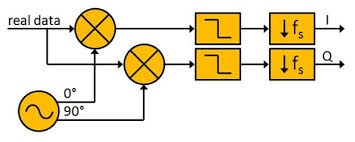Satellite Downconverter

A low-noise block downconverter (LNB) is the receiving device mounted on satellite dishes used for satellite data reception, which collects the radio waves from the dish and converts them to a signal which is sent through a cable to the receiver inside the building. Also called a low-noise block, low-noise converter (LNC), or even low-noise downconverter (LND), the device is sometimes inaccurately called a low-noise amplifier (LNA).
Downconverters are designed to support a wide range of satellite broadcast and satellite communications applications. Featuring a sophisticated, low-noise synthesizer design, the downconverters can be used to receive signals from the RF-band and produce an output signal in the IF (70/140/720 MHz) or L-band with industry-leading spectral performance. Leveraging shared oscillators in multichannel devices, downconverters can also be utilized in systems where an accurate phase relationship between channels is required (e.g., monopuls tracking system) to address the complex needs of today’s satellite operators.
Low-noise block downconverter (LNB)
https://en.wikipedia.org/wiki/Low-noise_block_downconverter
https://en.wikipedia.org/wiki/Low-noise_block_downconverter#LNBFs
http://www.satsig.net/lnb/explanation-description-lnb.htm
LNB with feedhorn (LNBF)
http://www.satsig.net/lnb/explanation-description-lnb.htm
Several Variations
C-band LNB
Ku-band LNB
Wideband LNB
Universal LNB ("Astra" LNB)
Multi-output LNBs
Dual, twin, quad, and octo LNBs
Quattro LNBs
Satellite channel router (SCR), or unicable LNBs
Optical-fibre LNBs
Monoblock LNBs